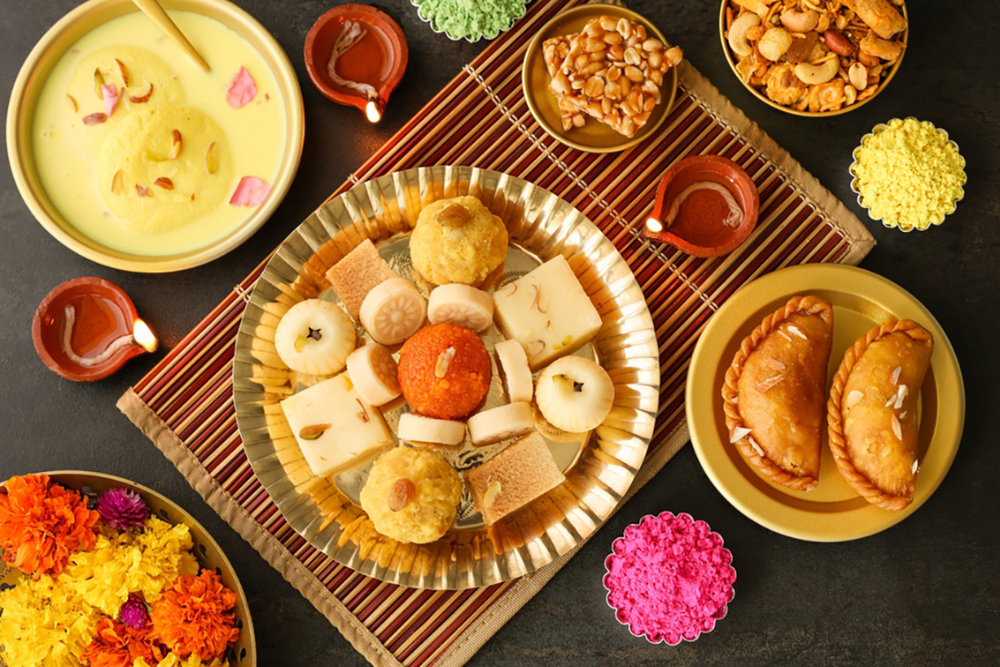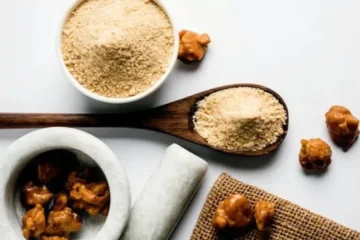Navratri fasting brings with it an array of sattvic recipes that are both light and nourishing. Among these, Hing in Navratri sweets is a unique twist that not only elevates flavour but also enhances digestion. Let’s explore how hing (asafoetida) blends into vrat-friendly desserts, creating balance and aroma.
Is hing traditionally used in sweets — how does it affect the flavour and aroma of vrat-friendly desserts?
Short Answer: Yes, hing has been used in select traditional sweets in small amounts. It adds earthy warmth, balances intense sweetness, and improves digestion, especially in desserts made with ghee, dry fruits, or jaggery.
Detailed Answer:
- Flavour Balance: Hing introduces a subtle earthy note that cuts through excessive sweetness in halwas and laddoos, making them more balanced.
- Aromatic Depth: Just a pinch enhances the fragrance of syrups and jaggery-based sweets, giving them a unique touch.
- Digestive Support: As rich sweets often cause heaviness, hing helps ease digestion by reducing bloating and discomfort.
- Traditional Usage: In certain Ayurvedic preparations, hing was added to sweet syrups or prasad to aid the stomach after festive feasts.
Are hing-infused sweets allowed during Navratri fasting — do they follow sattvic cooking rules?
Short Answer: Yes, hing in small amounts is considered sattvic and can be used in vrat-friendly sweets, especially when paired with ghee, nuts, and flours like singhara or rajgira.
Detailed Answer:
- Sattvic Nature: Hing in powdered or crystalline form is considered sattvic when used sparingly, making it suitable for Navratri fasting recipes.
- Common Pairings: Hing blends beautifully with vrat-safe flours (singhara, kuttu, rajgira) and dry fruits, adding balance.
- Digestive Alignment: Since sattvic food emphasises lightness and purity, hing helps digest rich ingredients like ghee and jaggery.
- Practical Example: A hing-tempered syrup poured over vrat pancakes ensures both taste and adherence to fasting traditions.
What are some unique hing-based sweet recipes I can try — beyond the usual coconut or sabudana desserts?
Short Answer: You can try hing-tempered dry fruit laddoos, singhara flour halwa with hing and cardamom, or jaggery syrup infused with hing for drizzling over vrat pancakes.
Detailed Answer:
- Hing-Tempered Dry Fruit Laddoos: Roasted almonds, cashews, and dates rolled into laddoos with a hing-ghee tempering.
- Singhara Flour Halwa with Hing: A vrat-friendly halwa where hing balances the sweetness of sugar or jaggery with cardamom.
- Jaggery Syrup Infused with Hing: Used as a drizzle for vrat pancakes, enhancing both aroma and digestion.
- Rajgira Hing Barfi: Amaranth flour sweetened with jaggery and tempered lightly with hing and ghee.
- Hing Almond Kheer: A milk-based dessert where hing is added with saffron and dry fruits for a warming twist.
Will hing help with digestion after eating rich sweets — especially those made with ghee or nuts?
Short Answer: Yes, hing is a natural digestive aid that prevents bloating and heaviness after consuming rich sweets made with ghee, jaggery, or dry fruits.
Detailed Answer:
- Carminative Effect: Hing reduces gas formation, making it perfect after eating nut-based laddoos or halwas.
- Bloating Relief: A pinch in syrups or tempering prevents post-meal discomfort.
- Stomach Soothing: Hing relaxes the digestive tract, easing digestion of heavy ingredients.
- Practical Tip: Even desserts like hing-laced halwa or laddoos can be enjoyed guilt-free due to its digestive benefits.
Can I prepare these hing-infused sweets in advance — how long do they stay fresh and fragrant?
Short Answer: Yes, hing-based sweets can be prepared in advance. Laddoos last 2–3 days, while halwas stay fresh for 1–2 days if stored in airtight containers at a cool spot.
Detailed Answer:
- Storage Containers: Always use airtight glass or steel containers to maintain aroma and prevent moisture absorption.
- Shelf Life: Dry fruit laddoos last up to 3 days, halwas 1–2 days, and jaggery syrups up to a week if refrigerated.
- Reheating: Halwas can be reheated on low flame with a little ghee to refresh flavour.
- Fragrance Preservation: Hing’s aroma intensifies slightly over time but remains pleasant if stored properly.
| Sweet Type | Storage Method | Shelf Life |
|---|---|---|
| Dry Fruit Laddoos | Airtight container, cool place | 2–3 Days |
| Singhara Halwa | Airtight container, refrigerate if needed | 1–2 Days |
| Jaggery Syrup with Hing | Glass jar, refrigerated | 5–7 Days |
Conclusion
Including Hing in Navratri sweets is a creative way to blend tradition with health. From laddoos to halwas, hing not only adds depth of flavour but also helps with digestion, making your fasting meals lighter and more enjoyable. With proper storage and sattvic alignment, these unique hing desserts can become festive favourites.





